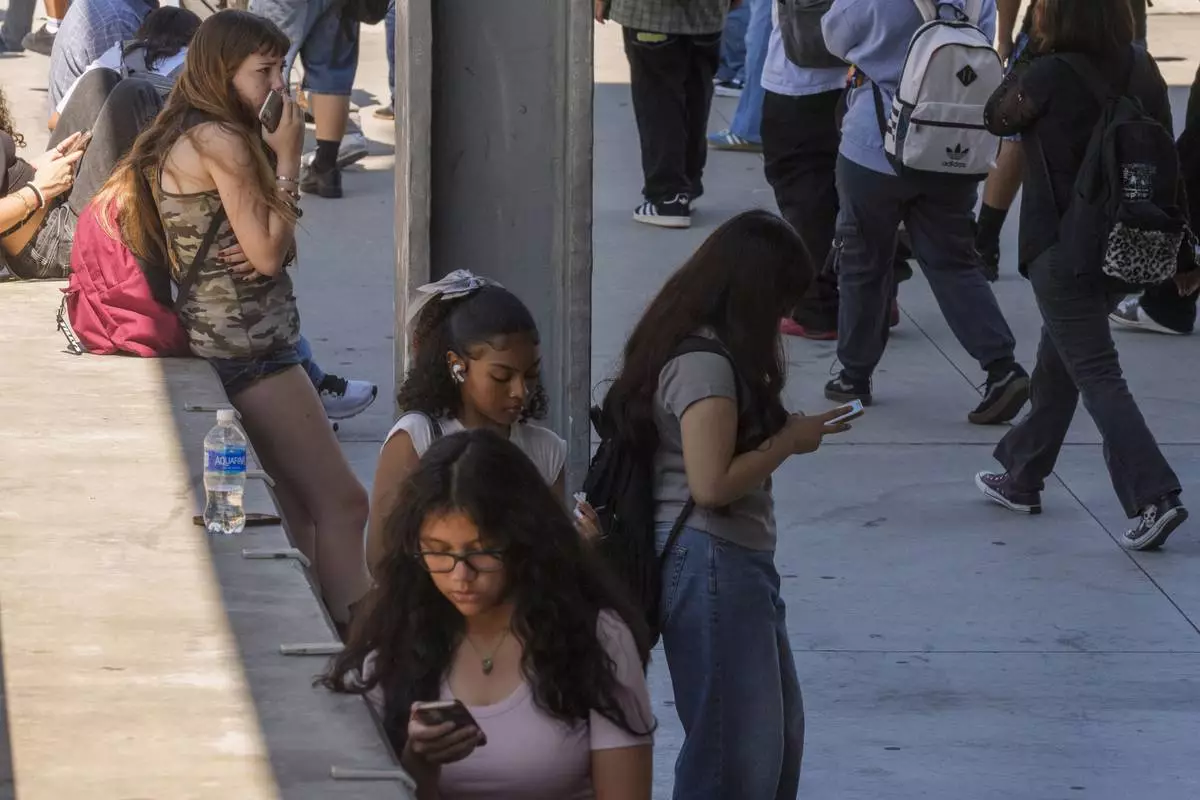BILLINGS, Mont. (AP) — The Biden administration on Friday asked an appeals court to revive a Trump-era rule that lifted remaining Endangered Species Act protections for gray wolves in the U.S.
If successful, the move would put the predators under state oversight nationwide and open the door for hunting to resume in the Great Lakes region after it was halted two years ago under court order.
Environmentalists had successfully sued when protections for wolves were lifted in former President Donald Trump’s final days in office.
Friday’s filing with the 9th U.S. District Court of Appeals was President Joe Biden administration’s first explicit step to revive that rule. Protections will remain in place pending the court’s decision.
The court filing follows years of political acrimony as wolves have repopulated some areas of the western U.S., sometimes attacking livestock and eating deer, elk and other big game.
Environmental groups want that expansion to continue since wolves still occupy only a fraction of their historic range.
Attempts to lift or reduce protections for wolves date to the first term of former President George W. Bush more than two decades ago and have continued with each subsequent administration.
They once roamed most of North America but were widely decimated by the mid-1900s in government-sponsored trapping and poisoning campaigns. Gray wolves were granted federal protections in 1974.
Each time the U.S. Fish and Wildlife Service declares them recovered, the agency is challenged in court. Wolves in different parts of the U.S. lost and regained protections multiple times in recent years.
“The U.S. Fish and Wildlife Service is focused on a concept of recovery that allows wolves to thrive on the landscape while respecting those who work and live in places that support them,” agency spokesperson Vanessa Kauffman said.
The administration is on the same side in the case as livestock and hunting groups, the National Rifle Association and Republican-led Utah.
It’s opposed by the Sierra Club, Center for Biological Diversity, Humane Society of the United States and other groups.
“While wolves are protected, they do very well, and when they lose protections, that recovery backslides,” said Collette Adkins with the Center for Biological Diversity. “We won for good reason at the district court.”
She said she was “saddened” officials were trying to reinstate the Trump administration's rule.
Efforts to restore wolves to date have been limited to a handful of regions. Federal officials earlier this year agreed to develop a first-ever national recovery plan, by December 2025, under a settlement in a separate lawsuit.
Kauffman declined to say whether that national plan would still be pursued if the government prevails in the 9th Circuit case.
But attorneys suggested in Friday's court filing that the government is ready to move on from gray wolf recovery, now that the species is no longer in danger of extinction.
“The ESA (Endangered Species Act) is clear: its goal is to prevent extinction, not to restore species to their pre-western settlement numbers and range," U.S. Department of Justice attorneys wrote.
The 2022 ruling that restored protections said wildlife officials had failed to show wolf populations could be sustained in the Midwest and portions of the West. Officials also didn’t adequately consider threats to wolves outside those core areas, said U.S. District Judge Jeffrey White in California.
The Great Lakes region has more than 4,000 wolves. More than 2,000 wolves occupy states in the Rocky Mountains and Pacific Northwest.
Congress circumvented the courts in 2011 and stripped federal safeguards in the northern U.S. Rocky Mountains. Thousands of wolves have since been killed in Montana, Idaho and Wyoming.
Lawmakers have continued to press for state control in the western Great Lakes region. When those states gained jurisdiction over wolves briefly under the Trump rule, trappers and hunters using hounds blew past harvest goals in Wisconsin and killed almost twice as many as planned.
Michigan and Minnesota have previously held hunts but not in recent years.
Wolves are present but no public hunting is allowed in states including Washington, Oregon, California and Colorado. They’ve never been protected in Alaska, where tens of thousands of the animals live.
The Biden administration last year rejected requests from conservation groups to restore protections for gray wolves across the northern Rockies. That decision, too, has been challenged.
State lawmakers in that region, which includes Yellowstone National Park and vast areas of wilderness, are intent on culling more wolf packs. But federal officials determined the predators were not in danger of being wiped out entirely under the states’ loosened hunting rules.
The U.S. also is home to small, struggling populations of red wolves in the mid-Atlantic region and Mexican wolves in the Southwest. Those populations are both protected as endangered.

FILE - This remote camera image provided by the U.S. Forest Service shows a female gray wolf and two of the three pups born in 2017 in the wilds of Lassen National Forest in northern California on June 29, 2017. (U.S. Forest Service via AP, File)
Instagram is making teen accounts private by default as it tries to make the platform safer for children amid a growing backlash against how social media affects young people's lives.
Beginning Tuesday in the U.S., U.K., Canada and Australia, anyone under 18 who signs up for Instagram will be placed into restrictive teen accounts and those with existing accounts will be migrated over the next 60 days. Teens in the European Union will see their accounts adjusted later this year.
Parent company Meta acknowledges that teenagers may lie about their age and says it will require them to verify their ages in more instances, like if they try to create a new account with an adult birthday. The Menlo Park, California company also said it is building technology that proactively finds teen accounts that pretend to be grownups and automatically places them into the restricted teen accounts.
The teen accounts will be private by default. Private messages are restricted so teens can only receive them from people they follow or are already connected to. “Sensitive content,” such as videos of people fighting or those promoting cosmetic procedures, will be limited, Meta said. Teens will also get notifications if they are on Instagram for more than 60 minutes and a “sleep mode” will be enabled that turns off notifications and sends auto-replies to direct messages from 10 p.m. until 7 a.m.
While these settings will be turned on for all teens, 16 and 17-year-olds will be able to turn them off. Kids under 16 will need their parents' permission to do so.
“The three concerns we’re hearing from parents are that their teens are seeing content that they don’t want to see or that they’re getting contacted by people they don’t want to be contacted by or that they’re spending too much time on the app,” said Naomi Gleit, head of product at Meta. “So teen accounts is really focused on addressing those three concerns.”
The announcement comes as the company faces lawsuits from dozens of U.S. states that accuse it of harming young people and contributing to the youth mental health crisis by knowingly and deliberately designing features on Instagram and Facebook that addict children to its platforms.
While Meta didn't give specifics on how the changes might affect its business, the company said the changes may mean that teens will use Instagram less in the short term. Emarketer analyst Jasmine Enberg said the revenue impact of the changes “will likely be minimal.”
“Even as Meta continues to prioritize teen safety, it’s unlikely that it’s going to make sweeping changes that would cause a major financial hit,” she said, adding that the teen accounts are unlikely to significantly affect how engaged teens are with Instagram “not in the least because there are still plenty of ways to circumvent the rules, and could even make them more motivated to work around the age limits.”
New York Attorney General Letitia James said Meta’s announcement was “an important first step, but much more needs to be done to ensure our kids are protected from the harms of social media.” James' office is working with other New York officials on how to implement a new state law intended to curb children’s access to what critics call addictive social media feeds.
Others were more critical. Nicole Gil, the co-founder and executive director of the nonprofit Accountable Tech, called Instagram's announcement the “latest attempt to avoid actual independent oversight and regulation and instead continue to self-regulate, jeopardizing the health, safety, and privacy of young people.”
“Today’s PR exercise falls short of the safety by design and accountability that young people and their parents deserve and only meaningful policy action can guarantee,” she said. "Meta’s business model is built on addicting its users and mining their data for profit; no amount of parental and teen controls Meta is proposing will change that.”
Sen. Marsha Blackburn (R-Tenn.), the co-author of the Kids Online Safety Act that recently passed the Senate, questioned the timing of the announcement “on the eve of a House markup” of the bill.
“Just like clockwork, the Kids Online Safety Act moves forward and industry comes out with a new set of self-enforcing guidelines,” she said.
In the past, Meta's efforts at addressing teen safety and mental health on its platforms have also been met with criticism that the changes don't go far enough. For instance, while kids will get a notification when they've spent 60 minutes on the app, they will be able to bypass it and continue scrolling.
That's unless the child's parents turn on “parental supervision” mode, where parents can limit teens' time on Instagram to a specific amount of time, such as 15 minutes.
With the latest changes, Meta is giving parents more options to oversee their kids' accounts. Those under 16 will need a parent or guardian's permission to change their settings to less restrictive ones. They can do this by setting up “parental supervision” on their accounts and connecting them to a parent or guardian.
Nick Clegg, Meta’s president of global affairs, said last week that parents don't use the parental controls the company has introduced in recent years.
Meta's Gleit said she thinks the teen accounts will incentivize parents to start using them.
“Parents will be able to see, via the family center, who is messaging their teen and hopefully have a conversation with their teen,” she said. “If there is bullying or harassment happening, parents will have visibility into who their teen’s following, who’s following their teen, who their teen has messaged in the past seven days and hopefully have some of these conversations and help them navigate these really difficult situations online.”
U.S. Surgeon General Vivek Murthy said last year that tech companies put too much responsibility on parents when it comes to keeping children safe on social media.
“We’re asking parents to manage a technology that’s rapidly evolving that fundamentally changes how their kids think about themselves, how they build friendships, how they experience the world — and technology, by the way, that prior generations never had to manage,” Murthy said in May 2023.
——
Associated Press writer Anthony Izaguirre in New York contributed to this report

File - The Instagram logo is seen on a cell phone in Boston, Oct. 14, 2022. (AP Photo/Michael Dwyer, File)

FILE - Students use their cellphones as they leave for the day the Ramon C. Cortines School of Visual and Performing Arts High School in downtown Los Angeles, Aug. 13, 2024. (AP Photo/Damian Dovarganes, File)












